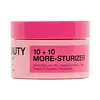What's inside
What's inside
 Key Ingredients
Key Ingredients

 Benefits
Benefits

 Concerns
Concerns

 Ingredients Side-by-side
Ingredients Side-by-side

Nelumbo Nucifera Flower Extract
Skin ConditioningGlycerin
HumectantPentylene Glycol
Skin ConditioningDipropylene Glycol
HumectantHydrogenated Polyisobutene
EmollientNiacinamide
SmoothingPrunus Amygdalus Dulcis Oil
Skin ConditioningXylitylglucoside
HumectantXylitol
Humectant1,2-Hexanediol
Skin ConditioningCaprylic/Capric Triglyceride
MaskingWater
Skin ConditioningSodium Polyacryloyldimethyl Taurate
Emulsion StabilisingPanthenol
Skin ConditioningCetearyl Olivate
Hydrogenated Polydecene
EmollientSorbitan Olivate
EmulsifyingHydroxyacetophenone
AntioxidantHydroxyethylcellulose
Emulsion StabilisingAllantoin
Skin ConditioningTrideceth-10
CleansingAnhydroxylitol
HumectantGlucose
HumectantNelumbo Nucifera Flower Extract, Glycerin, Pentylene Glycol, Dipropylene Glycol, Hydrogenated Polyisobutene, Niacinamide, Prunus Amygdalus Dulcis Oil, Xylitylglucoside, Xylitol, 1,2-Hexanediol, Caprylic/Capric Triglyceride, Water, Sodium Polyacryloyldimethyl Taurate, Panthenol, Cetearyl Olivate, Hydrogenated Polydecene, Sorbitan Olivate, Hydroxyacetophenone, Hydroxyethylcellulose, Allantoin, Trideceth-10, Anhydroxylitol, Glucose
Water
Skin ConditioningGlycerin
HumectantDimethicone
EmollientButyrospermum Parkii Butter
Skin ConditioningCaprylic/Capric/Myristic/Stearic Triglyceride
EmollientC12-15 Alkyl Benzoate
Antimicrobial3-O-Ethyl Ascorbic Acid
Skin ConditioningTapioca Starch
Cetearyl Alcohol
EmollientArachidyl Alcohol
EmollientSqualane
EmollientCoco-Caprylate/Caprate
EmollientPentaerythrityl Tetraisostearate
EmollientTridecyl Trimellitate
EmollientPalmitoyl Tetrapeptide-7
Skin ConditioningPalmitoyl Tripeptide-1
Skin ConditioningTetrahexyldecyl Ascorbate
AntioxidantCeramide NP
Skin ConditioningCaprylyl Glycol
EmollientCaprylyl/Capryl Glucoside
CleansingLinoleic Acid
CleansingCitric Acid
BufferingPhytosterols
Skin ConditioningGlucose
HumectantSodium Acrylate/Sodium Acryloyldimethyl Taurate Copolymer
Emulsion StabilisingBehenyl Alcohol
EmollientPolyisobutene
Bis-Diglyceryl Polyacyladipate-2
EmollientHydroxyacetophenone
Antioxidant1,2-Hexanediol
Skin ConditioningCetearyl Glucoside
EmulsifyingArachidyl Glucoside
EmulsifyingCarrageenan
Sorbitan Laurate
EmulsifyingSodium Phytate
C18-36 Acid Glycol Ester
EmollientC18-36 Acid Triglyceride
EmollientWater, Glycerin, Dimethicone, Butyrospermum Parkii Butter, Caprylic/Capric/Myristic/Stearic Triglyceride, C12-15 Alkyl Benzoate, 3-O-Ethyl Ascorbic Acid, Tapioca Starch, Cetearyl Alcohol, Arachidyl Alcohol, Squalane, Coco-Caprylate/Caprate, Pentaerythrityl Tetraisostearate, Tridecyl Trimellitate, Palmitoyl Tetrapeptide-7, Palmitoyl Tripeptide-1, Tetrahexyldecyl Ascorbate, Ceramide NP, Caprylyl Glycol, Caprylyl/Capryl Glucoside, Linoleic Acid, Citric Acid, Phytosterols, Glucose, Sodium Acrylate/Sodium Acryloyldimethyl Taurate Copolymer, Behenyl Alcohol, Polyisobutene, Bis-Diglyceryl Polyacyladipate-2, Hydroxyacetophenone, 1,2-Hexanediol, Cetearyl Glucoside, Arachidyl Glucoside, Carrageenan, Sorbitan Laurate, Sodium Phytate, C18-36 Acid Glycol Ester, C18-36 Acid Triglyceride
 Reviews
Reviews

Ingredients Explained
These ingredients are found in both products.
Ingredients higher up in an ingredient list are typically present in a larger amount.
1,2-Hexanediol is a synthetic liquid and another multi-functional powerhouse.
It is a:
- Humectant, drawing moisture into the skin
- Emollient, helping to soften skin
- Solvent, dispersing and stabilizing formulas
- Preservative booster, enhancing the antimicrobial activity of other preservatives
Glucose is a simple sugar and is the most important source of energy in all organisms.
In skincare, glucose is used to hydrate the skin. It also acts as a prebiotic for our natural biome.
Glucose is hydrating due to its humectant property. As a humectant, glucose draws moisture from the air and from deeper levels in the skin.
Our skin contains many sugars that act as prebiotics and help strengthen our natural microbiome. Having a healthy microbiome helps protect our skin from harmful bacteria and other contaminants.
Studies show glucose may help with fading discoloration and pigmentation. This is because our skin metabolizes glucose into lactic acid. Lactic acid is an AHA that helps exfoliate the top layer of skin.
Learn more about GlucoseGlycerin is already naturally found in your skin. It helps moisturize and protect your skin.
A study from 2016 found glycerin to be more effective as a humectant than AHAs and hyaluronic acid.
As a humectant, it helps the skin stay hydrated by pulling moisture to your skin. The low molecular weight of glycerin allows it to pull moisture into the deeper layers of your skin.
Hydrated skin improves your skin barrier; Your skin barrier helps protect against irritants and bacteria.
Glycerin has also been found to have antimicrobial and antiviral properties. Due to these properties, glycerin is often used in wound and burn treatments.
In cosmetics, glycerin is usually derived from plants such as soybean or palm. However, it can also be sourced from animals, such as tallow or animal fat.
This ingredient is organic, colorless, odorless, and non-toxic.
Glycerin is the name for this ingredient in American English. British English uses Glycerol/Glycerine.
Learn more about GlycerinHydroxyacetophenone is antioxidant with skin conditioning and soothing properties. It also boosts the efficiency of preservatives.
This ingredient is not irritating or sensitizing.
Water. It's the most common cosmetic ingredient of all. You'll usually see it at the top of ingredient lists, meaning that it makes up the largest part of the product.
So why is it so popular? Water most often acts as a solvent - this means that it helps dissolve other ingredients into the formulation.
You'll also recognize water as that liquid we all need to stay alive. If you see this, drink a glass of water. Stay hydrated!
Learn more about Water